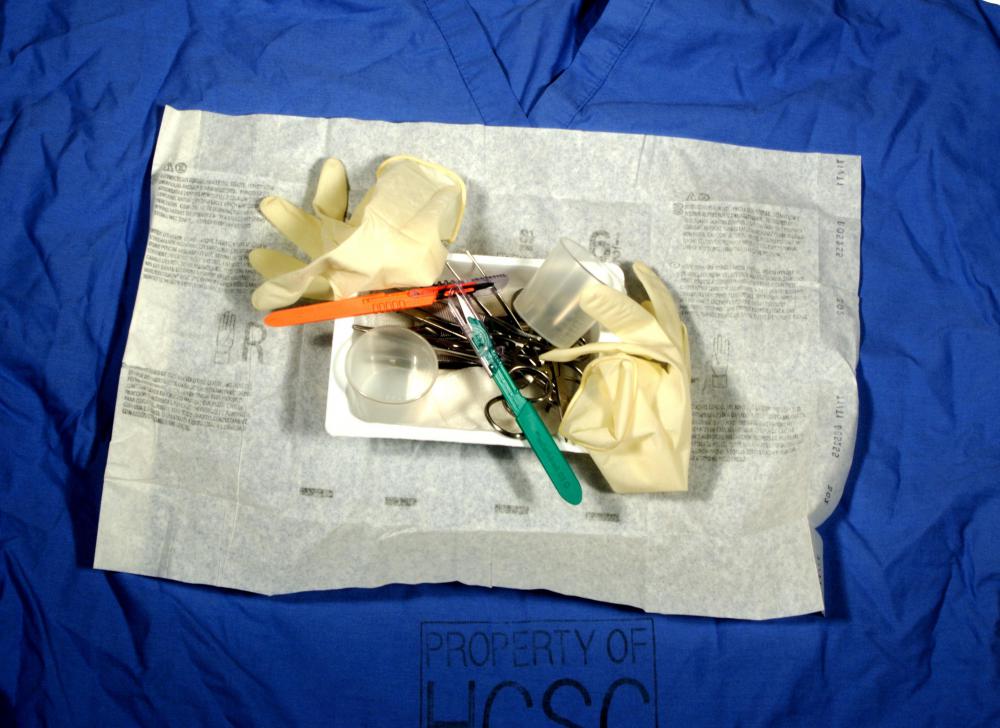At WiseGEEK, we're committed to delivering accurate, trustworthy information. Our expert-authored content is rigorously fact-checked and sourced from credible authorities. Discover how we uphold the highest standards in providing you with reliable knowledge.
What Is a Silk Suture?
A silk suture is a type of wound closure used in surgery and other medical procedures requiring stitches. It’s usually a braided thread that can come in varying strand densities and lengths, and it’s made of silk fibers. There are many different types of suturing threads available in most places, and silk isn’t always the best choice. A lot depends on the circumstances and the type of wound at issue. Silk fibers are usually very long-lasting, which can make them really good in situations of serious damage where the body needs a substantial amount of time to heal itself. Despite being almost entirely “all natural,” this sort of suture can often cause a lot of irritation at the site, and as such, it usually requires a lot of care and upkeep to avoid infection and inflammation. Medical experts sometimes choose less risky options for patients with other complicating factors.
Wound Closure Basics

When it comes to closing wounds, there are usually a number of options ranging from staples to tape and adhesive skin bonds. Stitches and sutures are usually reserved for the deepest wounds that need longer to heal. In general, the primary purpose of sutures of all varieties is to maintain tensile strength across the wound as the body heals and grows connective tissues around the area.

Sutures can be made of many different materials. Fibers made of silk typically come from the cocoons of the silk worm, the same as silk used for fabrics and clothing. They are very durable, and in an earlier era were the primary choice for surgeries; today, synthetic fibers have replaced them in most places for most routine operations.
Primary Benefits of Silk

The biggest benefit of a silk-made suture is usually its durability. This type of material is typically not absorbed quickly by the body, and strengthens wounded tissues so that they may have time to heal and repair themselves. The sutures may lose their tensile strength after about one year of placement, but not usually before then.
A proper silk suture should not fray or contain any form of irritant. It also should maintain tensile strength long enough for a wound to heal and should remain strong without mechanical assistance. In most places this sort of suture is available in a variety of colors, though the dyes used to make these colors are often subject to pretty strict regulation and safety certifications. Darker colors are typically preferable in situations where thread should remain visible against the tissue.
Available Strand Types

In most places, silk sutures are available as either monofilament or multi-filament strands. A monofilament strand consists of one singular fiber. It has a low threshold for infection in that it does not easily harbor pathogens. Its thin nature also allows it to pass easily through tissues. It is, however, quite delicate, and great care must be taken when tying it. If it’s pulled too harshly or knotted improperly, it can nick or break, which can compromise the integrity of the closure.

The multi-filament type is comprised of multiple threads that are either braided or twisted together. This kind of suture is stronger than a monofilament and maintains greater tensile strength. On the downside, though, its braided nature can allow for the introduction of pathogens into the wound area and may create a higher probability of infection.
Importance of Sterility
Like almost any wound closure, a silk suture is a foreign entity placed within the body and it can cause infection. For this reason, it is important to maintain sterility around the site of the sutures and to ensure that the sutures themselves are sterile before using them. Silk often has an enhanced risk of infection, and as such, a course of antibiotics is generally prescribed as a precautionary measure after treatment to prevent adverse reaction.
Additionally, it’s often the case that these sorts of sutures tend to cause an immediate inflammation in the tissues in which they are placed due to the natural properties of the silk itself. This swelling generally subsides as the tissues begin to grow around the sutures and encapsulate them. This typically occurs within two to three weeks of their initial placement.
AS FEATURED ON:
AS FEATURED ON:















Discuss this Article
Post your comments